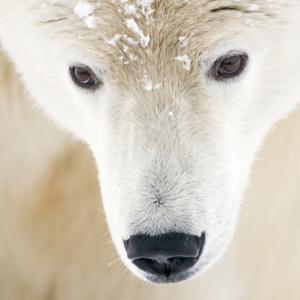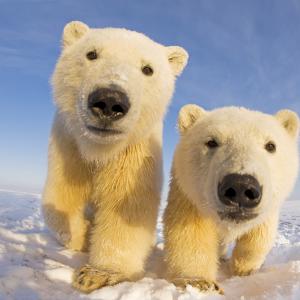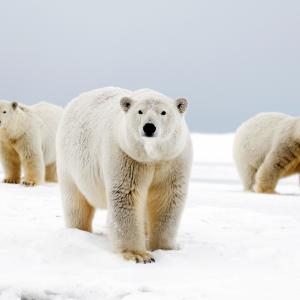In April 2016, I joined scientists from the Government of Nunavut in the Canadian Arctic who were conducting an innovative population survey of polar bears. Why? Because in order to help conserve this iconic species, we need better data to accurately assess how climate change will affect them. And that’s where innovation and technology comes in…
Polar bears are at a crossroads. The greatest threat to their survival is climate change and the predicted loss of their sea ice habitat over the coming decades. But it’s not a uniform picture across the Arctic. Although the bears are doing well in many areas, they’re declining in others. With much of the Arctic in meltdown, we could see polar bear numbers reduced by a third by the middle of this century.
Surprisingly, we don’t know for certain how many bears roam the Arctic. The best estimate is about 26,000 in the wild, but there could be anywhere between 22,000 to 31,000 bears. The environment to which they’ve adapted to survive over millennia is vast, harsh and a difficult place for scientists to work – and the bears blend in well to their Arctic icescape.
For such an iconic, apex predator, it still concerns me that we don’t have enough basic information to accurately assess what’s happening to polar bears on a global scale, and how best to safeguard healthy populations.
About 60% of the world’s polar bears and 13 of the 19 ‘subpopulations’ are in or shared with Canada. Currently, six of those polar bear subpopulations are assessed to be stable, one is increasing, and three are in decline. We just don’t have sufficient data to know what’s happening to the rest.
M’Clintock Channel in the Canadian Arctic is one of the 19 subpopulations and it’s particularly important as the sea ice there does not entirely break up over summer – so it remains critical feeding habitat for bears following the lean winter months.
Solving the polar bear puzzle
I’ve joined the population survey team in Resolute Bay in the Canadian Arctic. Resolute is one of the coldest inhabited places in the world, and it’s so far north that you often have to look south to see the northern lights. The locals joke that it’s not quite the end of the Earth – but you can see it from here!
It’s about -45°C with wind-chill when I step off the plane and meet Markus Dyck, the Government of Nunavut’s senior polar bear biologist. We’re here to undertake fieldwork in M’Clintock Channel, which will contribute towards an accurate population estimate, and help put together a small piece of the polar bear population puzzle.
Unfortunately, our helicopter is stuck in bad weather further south, in Goose Bay. While we wait for it to arrive, we use the time to run through the protocols for bear, seal and sea ice observations. We also undertake a recce flight in a ski-mounted Twin Otter aircraft to part of our study area, Cape Webb on Prince of Wales Island.
We fly 10-mile transects at an altitude of 300ft, covering an area around 3,700 km2. With only one polar bear sighting in this vast area, we conclude that this is low-density bear habitat. We abandon early season plans to work out of Cape Webb on Prince of Wales Island.
With the arrival of our helicopter, we move further south and set up camp in the small field hut at Cape Sydney at the northern end of King William Island (North 69◦50.667, West 97◦39.159).
As the sun sets on our first evening at Cape Sydney, I catch a fleeting glimpse of a young bear out on the distant ice. It passes between rumples of ice on the frozen ocean and then it’s gone. I suspect it’s a yearling or two-year old, so its mother must be nearby.
Over the next three days, the winds blow up to 45 knots and visibility drops. We are grounded. An inquisitive Arctic fox ambles up near the hut to check out its new neighbours. An Arctic hare is startled as I open the door, and bounds off on its disproportionately large feet. And two curious, brilliant-white ptarmigan drop in to check us out, before scratching out seeds along the exposed parts of the shore. I wonder if it’s the same two that I saw up on CairnGorm Mountain in Scotland earlier this year. The Arctic is closer to the UK than you might think: it’s in our backyard and what happens there affects us all.
As the winds subside, polar bear tracks in the fresh snow outside the front door of our hut suggest the mother and cub took a keener interest in us than we were aware of…
“Bear! Starboard at 9 o’clock”. In the excitement, it takes a fraction of a second to realise that the crackling voice through the headphone in the back of the helicopter is my own. I’ve spotted the first bear of this year’s survey. It’s a big male, he’s heard us and he’s on the move. We have a good visual on him so our pilot Gerard brings the helicopter in to land and Mike, the laboratory technician, and I jump out with the emergency bag.
Polar bear biologist Markus shifts to the rear seat, darting rifle in hand, and they take off. We see the helicopter hovering over the bear: Markus gets him in the haunch with a single biopsy dart, which falls immediately onto the ice. The whole process takes less than three minutes. It’s harmless to the bear and less intrusive than tranquilising and marking it.
We collect the dart which has a very valuable piece of polar bear hair, skin and fat. Mike will dry the skin sample before sending it off to a genetics laboratory for analysis. The sample will give us an unique genetic ‘fingerprint’ of that bear so it can be recognised in a population survey if it’s counted again. The fat sample is frozen and will be sent off for diet analysis to give us a picture of the health of the bear and what it’s been feeding on over the winter months.
All in a day’s work
Over the course of the next few hours, we dart a further two bears, but we lose one dart as it falls into a crack in the ice. We’ve been out for about nine hours and spotted six bears in total. We’ve flown nine transects of about 40km at 300 ft above sea level, travelling at 100 mph. It’s been one amazing day, a truly inspiring introduction to polar bear fieldwork.
During the next week, we undertake a further two missions and biopsy four more bears, as well as recording sea ice data and sightings of seals and musk oxen. Then it’s time for me to head home: Markus and the team have another month of surveying ahead of them, during which time they’ll encounter about 90 bears in total.
With my bags packed, I go for a last walk out on the frozen Arctic Ocean. It’s 11pm and the sun is still lingering just above the horizon. It casts shades of orange, red and purple across the icy landscape. I’m alone, and my hands are thrust deep into the pockets of my jacket, gripping the 142-decibel polar bear deterrent – just in case.
The beating heart of our planet
As my footsteps crunch through the layers of crisp spring snow covering the sea ice, my thoughts turn to home and to my son: the sunset reminds me of his blazing orange hair. At two years old, he’s the same age as a polar bear cub preparing to leave its mother and strike out on its own. Perhaps also the same age as the cub I caught a fleeting glimpse of on my first night in Cape Sydney.
I desperately want my son to grow up in a world where sea ice still covers much of the Arctic Ocean throughout the year, and where polar bears continue to roam across their entire range in healthy numbers and thrive alongside Arctic people.
The Arctic is changing. And it’s changing faster than almost anywhere else on our planet. Sea ice is in decline during all seasons, particularly the summer. That’s seriously concerning, because the seasonal sea ice dictates the rhythm of life up here in the Arctic. It supports entire ecosystems, from plankton to polar bears and people. And at a global scale, the annual freeze and thaw of sea ice represents the beating heart of our planet.
In order to help conserve and manage polar bears into the future, we need to understand them now. And we can only hope to do that through a combination of traditional knowledge and new technology.
The traditional knowledge comes from people such as the Inuit, who have lived alongside polar bears for many thousands of years, and who have a deep and unparalleled respect for the Arctic’s highest predator. And the ‘new’ comes from innovative research techniques such as biopsy darting for genetic marking and fingerprinting, which I feel immensely privileged to have been involved in.
Climate warming is predicted to drive change in Arctic wildlife at an unprecedented rate. So it’s exactly this sort of study led by the Government of Nunavut which we need to do more of across the Arctic. This will help us understand how polar bears are responding to climate change now, and what we need to do to secure a future for these icons of the ice.
WWF-UK is grateful to the Government of Nunavut for the opportunity to participate in this field study.

 Adopt a polar bear
Adopt a polar bear
 Polar bear: a powerful predator on ice
Polar bear: a powerful predator on ice
 Top 10 facts about polar bears
Top 10 facts about polar bears